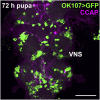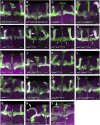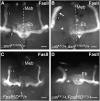unfulfilled interacting genes display branch-specific roles in the development of mushroom body axons in Drosophila melanogaster
- PMID: 24558265
- PMCID: PMC4577660
- DOI: 10.1534/g3.113.009829
unfulfilled interacting genes display branch-specific roles in the development of mushroom body axons in Drosophila melanogaster
Abstract
The mushroom body (MB) of Drosophila melanogaster is an organized collection of interneurons that is required for learning and memory. Each of the three subtypes of MB neurons, γ, α'/β', and α/β, branch at some point during their development, providing an excellent model in which to study the genetic regulation of axon branching. Given the sequential birth order and the unique patterning of MB neurons, it is likely that specific gene cascades are required for the different guidance events that form the characteristic lobes of the MB. The nuclear receptor UNFULFILLED (UNF), a transcription factor, is required for the differentiation of all MB neurons. We have developed and used a classical genetic suppressor screen that takes advantage of the fact that ectopic expression of unf causes lethality to identify candidate genes that act downstream of UNF. We hypothesized that reducing the copy number of unf-interacting genes will suppress the unf-induced lethality. We have identified 19 candidate genes that when mutated suppress the unf-induced lethality. To test whether candidate genes impact MB development, we performed a secondary phenotypic screen in which the morphologies of the MBs in animals heterozygous for unf and a specific candidate gene were analyzed. Medial MB lobes were thin, missing, or misguided dorsally in five double heterozygote combinations (;unf/+;axin/+, unf/+;Fps85D/+, ;unf/+;Tsc1/+, ;unf/+;Rheb/+, ;unf/+;msn/+). Dorsal MB lobes were missing in ;unf/+;DopR2/+ or misprojecting beyond the termination point in ;unf/+;Sytβ double heterozygotes. These data suggest that unf and unf-interacting genes play specific roles in axon development in a branch-specific manner.
Keywords: CG16801; dHR51; neuronal differentiation; nuclear receptor; suppressor screen.
Figures






Similar articles
-
The unfulfilled gene is required for the development of mushroom body neuropil in Drosophila.Neural Dev. 2010 Feb 1;5:4. doi: 10.1186/1749-8104-5-4. Neural Dev. 2010. PMID: 20122139 Free PMC article.
-
Nuclear receptor unfulfilled regulates axonal guidance and cell identity of Drosophila mushroom body neurons.PLoS One. 2009 Dec 22;4(12):e8392. doi: 10.1371/journal.pone.0008392. PLoS One. 2009. PMID: 20027309 Free PMC article.
-
Contrasting developmental axon regrowth and neurite sprouting of Drosophila mushroom body neurons reveals shared and unique molecular mechanisms.Dev Neurobiol. 2016 Mar;76(3):262-76. doi: 10.1002/dneu.22312. Epub 2015 Jun 10. Dev Neurobiol. 2016. PMID: 26037037 Free PMC article.
-
Nitric Oxide as a Switching Mechanism between Axon Degeneration and Regrowth during Developmental Remodeling.Cell. 2016 Jan 14;164(1-2):170-182. doi: 10.1016/j.cell.2015.11.047. Cell. 2016. PMID: 26771490 Free PMC article.
-
The unfulfilled gene and nervous system development in Drosophila.Biochim Biophys Acta. 2015 Feb;1849(2):217-23. doi: 10.1016/j.bbagrm.2014.06.013. Epub 2014 Jun 19. Biochim Biophys Acta. 2015. PMID: 24953188 Review.
Cited by
-
Pathogenic Huntington Alters BMP Signaling and Synaptic Growth through Local Disruptions of Endosomal Compartments.J Neurosci. 2017 Mar 22;37(12):3425-3439. doi: 10.1523/JNEUROSCI.2752-16.2017. Epub 2017 Feb 24. J Neurosci. 2017. PMID: 28235896 Free PMC article.
-
The making of the Drosophila mushroom body.Front Physiol. 2023 Jan 13;14:1091248. doi: 10.3389/fphys.2023.1091248. eCollection 2023. Front Physiol. 2023. PMID: 36711013 Free PMC article. Review.
-
The genetic basis of natural variation in mushroom body size in Drosophila melanogaster.Nat Commun. 2015 Dec 11;6:10115. doi: 10.1038/ncomms10115. Nat Commun. 2015. PMID: 26656654 Free PMC article.
References
-
- Abrell S., Jackle H., 2001. Axon guidance of Drosophila SNb motoneurons depends on the cooperative action of muscular Kruppel and neuronal capricious activities. Mech. Dev. 109: 3–12. - PubMed
-
- Adachi Y., Hauck B., Clements J., Kawauchi H., Kurusu M., et al. , 2003. Conserved cis-regulatory modules mediate complex neural expression patterns of the eyeless gene in the Drosophila brain. Mech. Dev. 120: 1113–1126. - PubMed
-
- Andres A. J., Thummel C. S., 1994. Methods for quantitative analysis of transcription in larvae and prepupae. Methods Cell Biol. 44: 565–573. - PubMed
Publication types
MeSH terms
Substances
LinkOut - more resources
Full Text Sources
Other Literature Sources
Molecular Biology Databases
Research Materials
Miscellaneous
